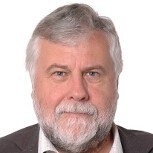
Keynote
Speaker
Bill Dawes
Whittle Laboratory, University of Cambridge
Title
Making the Digital Twin Real: Challenges for Simulation
Abstract
"Digitalisation", Industry 4.0, the Digital Twin, Data-driven design & manufacturing are set to revolutionise the way we do business. This presentation considers this in the engineering world of power generation, gas turbines & power plant - and asks the question: What will it take to make a Digital Twin real.
A Digital Twin with physics-based simulation at its heart will need to be able to represent & manage huge geometries over scales ranging from individual components like gas turbine blades through to assemblies and on to systems at the level of complete power plant. This will need to be distributed across parallel computer resource, perhaps the Cloud, supporting huge, conjugate, aero-thermal-mechanical simulations (on huge meshes). Data-driven feedback derived from field data, in-service monitoring, damage, degradation, etc. will need to be incorporated into improved design & manufacturing – via the geometry.
This presentation will set out these issues, quantify them & review the available routes forward.
Biography: Bill Dawes
 Aeronautical Engineering and Director of the Whittle Laboratory at Cambridge University. After completing a PhD at Cambridge he worked for the Central Electricity Generating Board where he developed and applied early computer-based flow simulation methods to steam turbine operational problems. Returning to Cambridge in 1984 as a Lecturer, he then worked on a range of numerical methods – by now called Computational Fluid Dynamics (CFD) - aimed at predicting fully 3D viscous flow in turbomachines. His structured blade-to-blade Navier-Stokes code (BT0B3d) became an industry standard design tool and was licenced to over 50 companies & organisations around the world. He then developed a state-of-the-art, solution-adaptive, unstructured version of this (NEWT) and broadened the application base beyond blading to shroud flows, secondary air systems and blade cooling. Bill’s research then expanded into CFD process integration and automatic design optimisation – especially using coupled sets of modelling hierarchies. Research draws inspiration from advanced computer graphics and physics-based animation and attempts to enable seamless and tactile integration between solid modelling, mesh generation, geometry editing and flow simulation. The resulting software & environment, BOXER, and the BOXER vision of an integrated End-to-End Parallel Simulation System, are being further developed in Cambridge Flow Solutions Ltd. Bill is a Fellow of the Royal Academy of Engineering and of the Royal Aeronautical Society and is a Chartered Engineer.
Aeronautical Engineering and Director of the Whittle Laboratory at Cambridge University. After completing a PhD at Cambridge he worked for the Central Electricity Generating Board where he developed and applied early computer-based flow simulation methods to steam turbine operational problems. Returning to Cambridge in 1984 as a Lecturer, he then worked on a range of numerical methods – by now called Computational Fluid Dynamics (CFD) - aimed at predicting fully 3D viscous flow in turbomachines. His structured blade-to-blade Navier-Stokes code (BT0B3d) became an industry standard design tool and was licenced to over 50 companies & organisations around the world. He then developed a state-of-the-art, solution-adaptive, unstructured version of this (NEWT) and broadened the application base beyond blading to shroud flows, secondary air systems and blade cooling. Bill’s research then expanded into CFD process integration and automatic design optimisation – especially using coupled sets of modelling hierarchies. Research draws inspiration from advanced computer graphics and physics-based animation and attempts to enable seamless and tactile integration between solid modelling, mesh generation, geometry editing and flow simulation. The resulting software & environment, BOXER, and the BOXER vision of an integrated End-to-End Parallel Simulation System, are being further developed in Cambridge Flow Solutions Ltd. Bill is a Fellow of the Royal Academy of Engineering and of the Royal Aeronautical Society and is a Chartered Engineer.
